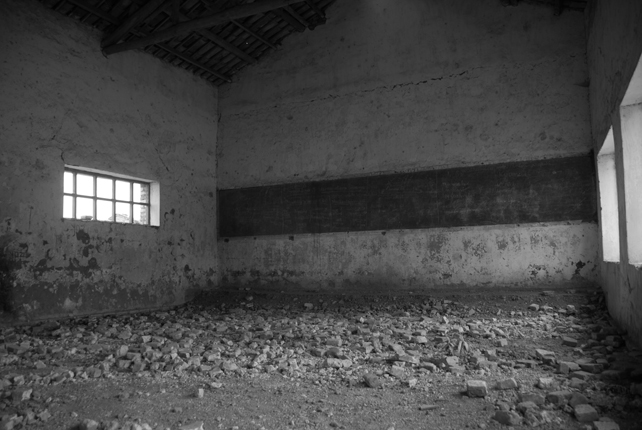
|
The Kibeho site is located in Southern Province. Click on the image for a slideshow of photographs. All photographs © 2002-2008 Jens Meierhenrich. |

|
The Kibeho site is located in Southern Province. Click on the image for a slideshow of photographs. All photographs © 2002-2008 Jens Meierhenrich. |
“Marie” (not her real name) was one of the lucky ones: Only ten children and one man, it seems, survived the genocidal attacks on an estimated 20,000 ethnic Tutsi barricaded inside this huge Roman Catholic church on April 13 and 14, 1994, in southwest Rwanda.
Now a soft-spoken young woman with delicate features, Marie says that the police and soldiers who converged on the hilltop parish, which included a training college for women, were undeterred by the locked doors of the sturdy 1930’s-era brick church: Methodically and rapidly, they dug holes for entrance near its walls, the better to pitch grenades inside at their trapped victims. More armed policemen and soldiers set upon those Tutsi who threw open the doors and rushed outside to escape the flames and destruction.
Perhaps like almost no other setting in Rwanda, Kibeho should have been a place of sanctuary if religious belief has any influence. Beginning in 1981, the site entered the annals of pilgrimage because here, it was claimed, the Virgin Mary, dressed all in white, descended in a cloud and appeared to a 16-year-old girl. Over the next decade, approximately 50 different “visionaries” like the schoolgirl claimed to witness such Marian apparitions.
In mid-April 1995, the people of Rwanda suffered again when a refugee camp on these grounds, estimated to hold up to 130,000 people displaced by upheaval in the wake of the genocide, was allegedly attacked by Rwandan government troops; an estimated 2,000 ethnic Hutu were reportedly killed by trampling, gunfire, or machete blows, according to the New York Times. (The government asserted that 300 had died.)
In 1999, Marie says, local people came together to collect the remains of victims still scattered all around. Then-president Pasteur Bizimungu broached the controversial subject of church complicity in the genocide at commemoration ceremonies that same year.
Now more than a decade later, bodies continue to emerge in the surrounding area, a fact attested to by the bulky bags tucked against the church’s inner walls that contain human remains awaiting dignified burial in April during the period of national commemoration. Today the church offers sustenance through religion while honoring those who perished from genocide in April 1994. A small memorial inside the church with the inscription April 14 (14. Mata 1994, in Kinyarwanda) displays 12 human skulls, while a sunken crypt that Marie quietly leads us to seemingly thousands of human bones, as well as former belongings of the victims such as leg braces. A lavender sign both commemorates and warns. “Let us remember those who died because of genocide. Fight its ideology. Those who committed the crimes should be punished.”
Copyright © 2010 Jens Meierhenrich. All rights reserved.